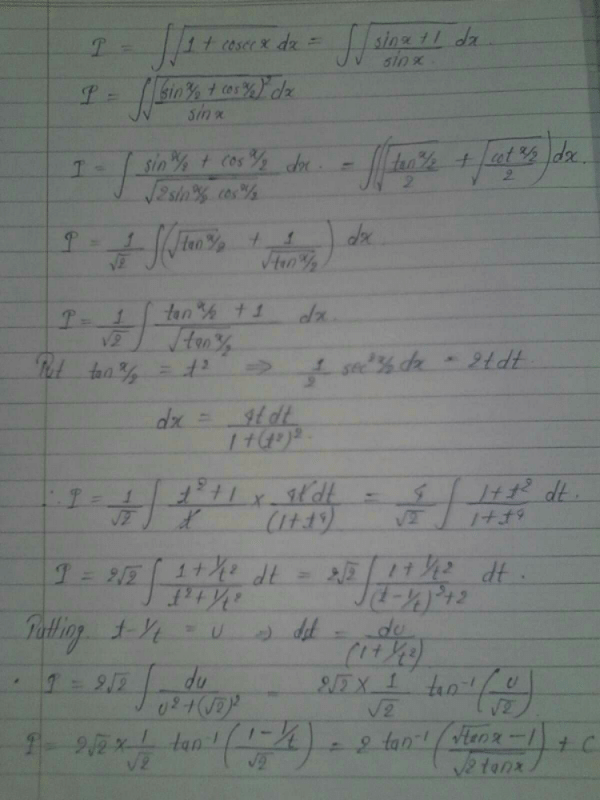Class 12 Exam > Class 12 Questions > Integration of root (1+ cosecx)?
Start Learning for Free
Integration of root (1+ cosecx)?
Most Upvoted Answer
Integration of root (1+ cosecx)?

Community Answer
Integration of root (1+ cosecx)?
Integration of √(1 + cosec(x))
To integrate the expression √(1 + cosec(x)), we can use different techniques such as trigonometric identities and substitution. Let's break down the process into steps for better understanding.
Step 1: Simplify the expression
We start by simplifying the expression inside the square root. The trigonometric identity that relates cosec(x) to sin(x) is:
cosec^2(x) = 1 + cot^2(x)
Rearranging this equation, we get:
cot^2(x) = cosec^2(x) - 1
Now, substitute this into the original expression:
√(1 + cosec(x)) = √(1 + cosec^2(x) - 1) = √(cosec^2(x)) = |cosec(x)|
Note that we used the absolute value sign because cosec(x) can be negative depending on the quadrant of x.
Step 2: Transform the expression
To simplify the absolute value of cosec(x), we can rewrite it using the reciprocal identity:
|cosec(x)| = |1/sin(x)| = 1/|sin(x)|
Step 3: Evaluate the integral
Now, we can proceed with integrating the expression:
∫ √(1 + cosec(x)) dx = ∫ (1/|sin(x)|) dx
To evaluate this integral, we can use a trigonometric substitution. Let's substitute sin(x) = t:
dx = dt/cos(x)
The integral then becomes:
∫ (1/|sin(x)|) dx = ∫ (1/|t|) (dt/cos(x))
Since |t| is always positive, we can remove the absolute value sign:
∫ (1/|sin(x)|) dx = ∫ (1/t) (dt/cos(x)) = ∫ (dt/cos(x))
Step 4: Simplify the integral
The integral ∫ (dt/cos(x)) can be evaluated as:
∫ (dt/cos(x)) = ∫ sec(x) dx = ln|sec(x) + tan(x)| + C
where C is the constant of integration.
Step 5: Final result
Combining all the steps, we have:
∫ √(1 + cosec(x)) dx = ln|sec(x) + tan(x)| + C
where C is the constant of integration.
To integrate the expression √(1 + cosec(x)), we can use different techniques such as trigonometric identities and substitution. Let's break down the process into steps for better understanding.
Step 1: Simplify the expression
We start by simplifying the expression inside the square root. The trigonometric identity that relates cosec(x) to sin(x) is:
cosec^2(x) = 1 + cot^2(x)
Rearranging this equation, we get:
cot^2(x) = cosec^2(x) - 1
Now, substitute this into the original expression:
√(1 + cosec(x)) = √(1 + cosec^2(x) - 1) = √(cosec^2(x)) = |cosec(x)|
Note that we used the absolute value sign because cosec(x) can be negative depending on the quadrant of x.
Step 2: Transform the expression
To simplify the absolute value of cosec(x), we can rewrite it using the reciprocal identity:
|cosec(x)| = |1/sin(x)| = 1/|sin(x)|
Step 3: Evaluate the integral
Now, we can proceed with integrating the expression:
∫ √(1 + cosec(x)) dx = ∫ (1/|sin(x)|) dx
To evaluate this integral, we can use a trigonometric substitution. Let's substitute sin(x) = t:
dx = dt/cos(x)
The integral then becomes:
∫ (1/|sin(x)|) dx = ∫ (1/|t|) (dt/cos(x))
Since |t| is always positive, we can remove the absolute value sign:
∫ (1/|sin(x)|) dx = ∫ (1/t) (dt/cos(x)) = ∫ (dt/cos(x))
Step 4: Simplify the integral
The integral ∫ (dt/cos(x)) can be evaluated as:
∫ (dt/cos(x)) = ∫ sec(x) dx = ln|sec(x) + tan(x)| + C
where C is the constant of integration.
Step 5: Final result
Combining all the steps, we have:
∫ √(1 + cosec(x)) dx = ln|sec(x) + tan(x)| + C
where C is the constant of integration.

|
Explore Courses for Class 12 exam
|

|
Similar Class 12 Doubts
Integration of root (1+ cosecx)?
Question Description
Integration of root (1+ cosecx)? for Class 12 2024 is part of Class 12 preparation. The Question and answers have been prepared according to the Class 12 exam syllabus. Information about Integration of root (1+ cosecx)? covers all topics & solutions for Class 12 2024 Exam. Find important definitions, questions, meanings, examples, exercises and tests below for Integration of root (1+ cosecx)?.
Integration of root (1+ cosecx)? for Class 12 2024 is part of Class 12 preparation. The Question and answers have been prepared according to the Class 12 exam syllabus. Information about Integration of root (1+ cosecx)? covers all topics & solutions for Class 12 2024 Exam. Find important definitions, questions, meanings, examples, exercises and tests below for Integration of root (1+ cosecx)?.
Solutions for Integration of root (1+ cosecx)? in English & in Hindi are available as part of our courses for Class 12.
Download more important topics, notes, lectures and mock test series for Class 12 Exam by signing up for free.
Here you can find the meaning of Integration of root (1+ cosecx)? defined & explained in the simplest way possible. Besides giving the explanation of
Integration of root (1+ cosecx)?, a detailed solution for Integration of root (1+ cosecx)? has been provided alongside types of Integration of root (1+ cosecx)? theory, EduRev gives you an
ample number of questions to practice Integration of root (1+ cosecx)? tests, examples and also practice Class 12 tests.

|
Explore Courses for Class 12 exam
|

|
Signup for Free!
Signup to see your scores go up within 7 days! Learn & Practice with 1000+ FREE Notes, Videos & Tests.



















